#biology reference
Explore tagged Tumblr posts
Text
holy shit eye colors in the world of project sekai is an incomplete dominant trait that's so cool arghhhh
(@201-klz-dead you better do well in bio)

Mafuyu notably has two-tone irises, with the lower part of them being blue and the upper part being purple. She is the only person in her family to have this trait, and it's apparent that it comes from a combination of her mother's blue eyes and her father's purple eyes.
#biology reference#genetic is actually rly cool other than the fact that it fucked me up with all the gender dysphoria and shit
478 notes
·
View notes
Text

Visual Comparison Of Bird Beaks And Their Uses
#ornithology#birds#beaks#evolution#darwinism#biology#zoology#interesting#chart#charts#reference#educational
20K notes
·
View notes
Text
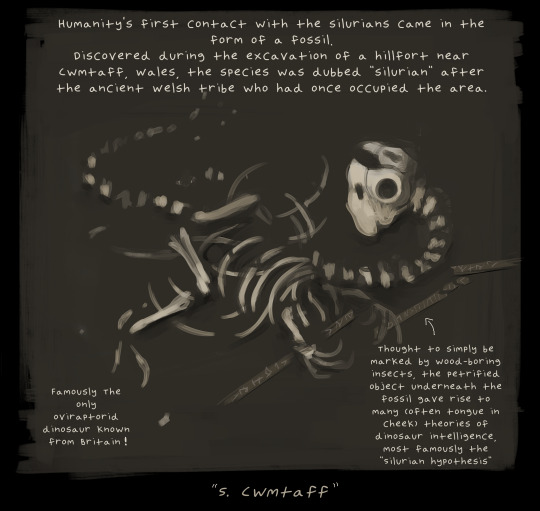

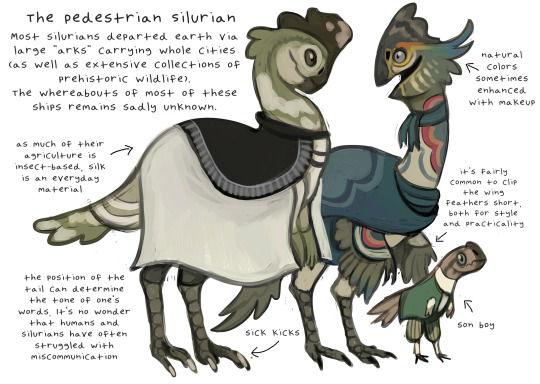
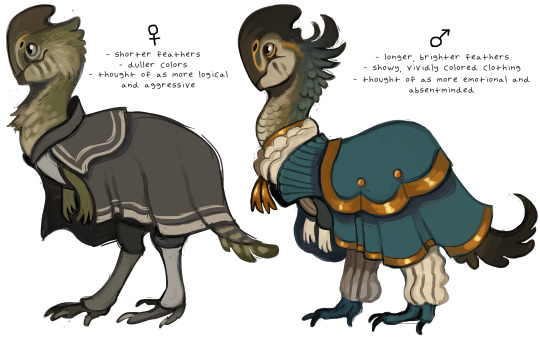

The genus Silurian ("Person of the Silures", in reference to the historical territory of Wales in which they were first found) was initially known only from a single fossil, notable in part for the unusual object fossilized alongside it (1). Though this was generally accepted to simply be a large petrified stick, the "Silurian Artifact" and the associated "Silurian Hypothesis" were often a point of discussion in the topic of dinosaur intelligence and the theory of pre-human civilizations. It wasn't until large-scale mining operations began to impede on their extensive networks of stasis chambers that the Silurians themselves finally woke up and were able to meet humankind in person. To the surprise of many (and dismay of a few) the Silurians were not the scaled, humanoid "dinosauroids" so often depicted, but colorful, feathered, and relatively goose-shaped. Most Silurians who were present in the planet's underground represent the gentry and high ranking military, who were given priority in the earth-based shelters. Most others were evacuated on large, extensive spaceships, all of which are yet to return to Earth. Due to this, the varied mindsets and cultures of the Silurians are in shambles at best, largely replaced by the speciesism and real estate concerns of the upper classes. (1) Much later, the original type fossil was identified as Rohlik, a student who fell to his death after attempting to drunkenly pole vault over a ravine with a large petrified stick.
#in universe cow tools is a reference to this#doctor who art tag#doctor who#All The Strange Strange Creatures#thank you rachel for reminding me of the origin of the term silurian . my life in your hands#speculative biology#silurians#my art
4K notes
·
View notes
Text

every time i make a meme the intended audience shrinks. shoutout to all 3 people this is for
#inaturalist#naturalist#nature#ecology#zoology#biology#birds#bird#birdblr#birding#hawk#hawks#sharp shinned hawk#those are all real field marks i just refuse to refer to them normally#hawk tourism#ornithology
600 notes
·
View notes
Text
Three girls discuss the new student that just entered the far side of the Quad.
Bianca: He’s a what now?
Enid: Gacha werewolf. It’s like a stupid rare subspecies of lycanthrope.
Wednesday: They are more of a mutation than a true subspecies.
Bianca: I’ll bite. Tell me more.
Enid: Okay, so like gacha werewolves are one of the contagious lycans, who can—
Bianca: —transmit lycanthropy. I know. I was actually awake during the lecture.
Enid: *blushes* Right! Well um—the bizarro thing is, the bite of a gacha doesn’t pass on full werewolfism.
Bianca: Huh? What’s that mean?
Wednesday: The recipient of the bite only receives a single lupine aspect associated with lycanthropes.
Bianca: You mean just—
Enid: Just the fur or claws. Or only the ears. Maybe the nose. Basically, they get ONE trait—
Bianca: 😦
Enid: —and they usually won’t know what that trait even is UNTIL the full moon.
Bianca: Jesus. That… that’s some kinda F’d.
Wednesday: It is delightfully tragic, especially since additional infections will bestow further traits. This leads many infected to continue pursuing bites in vain hopes of becoming a “complete” werewolf.
Bianca: Huh. I guess that makes sense. But why is it in vain?
Wednesday: Firstly, the traits differ in rarity. For example, fur is notably more common than canine teeth, while accelerated healing is exceptionally rare.
Bianca: So becoming a complete werewolf takes hundreds of bites? Less if you’re lucky? That doesn’t sound too terrible.
Wednesday: Secondly, the traits compound.
Bianca:
Bianca: What?
Enid: She means they stack. Just ’cause a gacha werewolf already has a trait doesn’t mean they can’t get the same one again. Multiple times, even.
Bianca: Shit.
Wednesday: Quite. That includes the far less desirable traits, such as vulnerability to silver or wolf’s bane, or even latent canine instincts like the juvenile urge to chase their own tail.
Enid: Yeah, it can get super bad. I once knew a girl who, on a full moon, would grow like thirty-six nipples, three tails, and fur only on her legs.
Bianca: 😟
Enid: She also could and would a smell a butt from over six miles away. *shudders*
Bianca: 😬
Bianca: That’s… geeze, that is fucking awful. So is that why they’re so rare? Because of how messed up the whole thing is? I’m guessing werewolf society closely monitors and regulates them.
Enid: Uhhhh… yes and no.
Bianca: What do you mean by—
Some student: HELP! GET A NURSE! SOMEONE SAID “SILVER” AROUND RALPH!
Other student: STOP SAYING SILVER AROUND—OHFUCK!!
Gacha werewolf Ralph: 😵
Bianca: 😨
Wednesday: As I said, some traits are more common than others, and Lady Luck can be a dreadfully cruel mistress.
Enid: Yeah, that dude really shoulda stopped at just one. I mean like seriously, what kind of dumbass—
*Ding!*
Enid: *checks phone* Ooh, my resin just replenished! Gimme a bit. This girl’s gotta grind herself some Genshin!
Bianca/Wednesday: 😑😒
Across the Quad: 😱😱 💀
#alternative outcast biology#gacha werewolves#werewolves#genshin impact reference#wednesday addams#enid sinclair#bianca barclay#wenclair#incorrect wenclair#incorrect wednesday addams#incorrect wednesday quotes#wednesday netflix#incorrect quotes#ficlet
155 notes
·
View notes
Text
Xa ontogeny
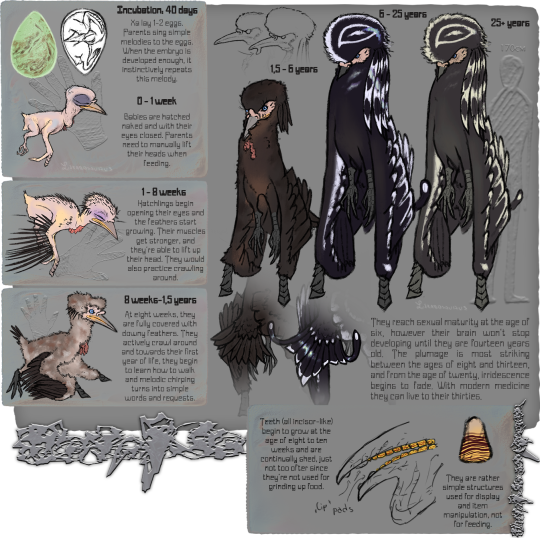
The Xa and how they grow. The brown-feathered kiddos past age of 1,5 are already able to fly somewhat. Xa don't show any sexual dimorphism, so there's only one Xa image for each life stage. Here's more about this sophont: https://www.tumblr.com/total-convergence/726112557515128832/tcxa
#speculative evolution#creature design#artists on tumblr#digital art#spec bio#spec evo#worldbuilding#speculative fiction#artwork#my art#art#reference sheet#bird art#small artist#digital artist#oc artist#drawing#illustration#scifi#scifi worldbuilding#imagination#oc art#oc#original species#speculative biology#bird oc#corvidae#magpie
409 notes
·
View notes
Text
Writing Notes: Death (& Cheating Death)
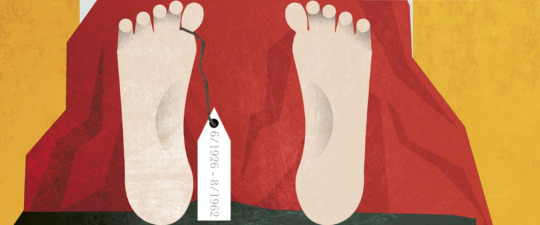
Oddly enough, not all experts – or even countries – agree on what death actually is.
Brain activity stops
Temperature drops
Cells break down
Organs decay
Bacteria produce gas
In Britain, death is said to happen when:
The person has lost the capacity to ever be conscious again.
All the functions of the brainstem (such as telling the heart to beat and the lungs to inflate) have stopped.
What happens when someone has died?
Almost at once, blood begins to drain from the little blood vessels near the surface of the skin. This makes it look pale.
Bodily tissue starts to break down very quickly. That’s why organs are removed for transplant as soon as possible after someone dies.
Some organs function for longer than others after death. Brain cells go quickly, in no more than about 3 or 4 minutes. But muscle and skin cells may last for hours – perhaps a whole day.
In fact, a corpse is still very much alive. No, the person isn’t alive any more, but all the bacteria inside the body, plus all the others that flock in, certainly are. As they eat the body, they produce all kinds of smelly gases. When there’s no flesh remaining, there’s nothing left to cause a smell.
In some conditions, this process of decay is disrupted. This can happen naturally, as in the cases of bodies falling into peat bogs and being preserved (because the acids in the peat essentially pickle the flesh). But it can be done on purpose too.
Mummification
After pharaohs and some other members of the nobility died in Ancient Egypt, their bodies were preserved.
Most of their organs were taken out (though their hearts were left in place).
To remove the brain, a thin metal stick was poked up into their nose then wiggled around.
This whisked the brain up, turning it into a runny slop that could drain out through the nostrils.
Next, their bodies were dried out for 40 days.
Then they were coated in natural preservatives (things that would stop the body decomposing), such as beeswax, and wrapped in many layers of linen.
This completed the process of mummification.
What happens if the head is chopped off?
In the past, some criminals had their heads cut off as punishment, and members of the public would go along to watch.
Some reported seeing chopped-off heads blinking or even attempting to speak.
In 1803, two German scientists investigated these reports.
They pounced on heads as they fell and shouted, ‘Do you hear me?’ None responded.
They concluded that the brain, when separated from the body, lost consciousness immediately – or at least too quickly to measure.
How quickly?
Modern estimates range between 2 and 7 seconds. Which is quick.
But it still means that a brain in a chopped-off head might have a genuine out-of-body experience.
CHEATING DEATH
Your body is pretty tough. And as you know, your brain works very hard to keep you alive. Some uncomfortable experiments have revealed the amazing things it can do. Take extreme heat, for example...
The Walk-in Oven
In the 18th century, a doctor in London called Charles Blagden built what was essentially an oven big enough for a person to walk inside.
He and his friends would stand inside it for as long as they could bear.
Blagden managed ten minutes at a temperature of 92.2 degrees Celsius.
His friend, a famous botanist called Joseph Banks, managed 99.4 degrees – but only for seven minutes.
Unsurprisingly, the volunteers’ skin warmed up dramatically.
But Blagden also took the temperature of their urine.
He did this right before and after the oven experience.
And he found that there was no change.
That meant that their inner ‘body temperature’ had stayed the same.
This showed the toughness of the human body – it can regulate its own temperature even when outside temperatures are extreme.
He also noticed that the volunteers sweated a lot. This led him to realize that sweating is important for cooling the body.
Some of what we know about the toughness of the human body comes not from experiments, but from accidents and ‘lucky’ escapes.
The Deep Freeze
When Erika Nordby was a toddler, she woke up one night and wandered out of her home in Canada.
It was the middle of winter, and freezing outside.
When she was finally found, her heart hadn’t been beating for at least 2 hours.
But Erika was carefully warmed up at a local hospital, and she made a full recovery.
Just a couple of weeks later, a two-year-old boy on a farm in the USA did almost exactly the same thing.
He also recovered fully.
It sounds extraordinary – but dying is the last thing that your body wants to do.
Falling from a Plane
On 24 March 1944, a British airman called Nicholas Alkemade was in an RAF plane flying over Germany.
His plane was hit and burst into flames.
By the time he got to his parachute, it was on fire. So he decided to jump.
He was 3 miles above ground and falling at 120 miles per hour.
‘It was very quiet,’ he recalled later. He had no sensation of falling.
‘I felt suspended in space.’
Suddenly, he found himself crashing through the branches of some pine trees.
He landed with a thud in a snowbank, in a sitting position.
He had somehow lost both his boots and had a sore knee and some minor scrapes. But otherwise he was fine.
After World War II, Alkemade got a job in a chemical plant.
While he was working with chlorine gas, his mask became loose.
He was exposed to dangerously high levels of the chemical.
He lay unconscious for 15 minutes before co-workers dragged him out. Miraculously, he survived.
After he returned to work, he was adjusting a pipe one day when it burst and sprayed him from head to foot with sulphuric acid.
He suffered extensive burns. But he survived.
Shortly after returning to work again, a 9-foot-long metal pole fell on him from a height and very nearly killed him.
Incredibly, he survived.
He then found a much safer job – as a furniture salesman.
Alkemade went on to die peacefully in his bed at the age of 64.
Source ⚜ More: Writing Notes & References Writing Notes: Autopsy ⚜ Word List: Kill ⚜ Decompose Worksheets: Death & Sacrifice
#writing notes#writeblr#writing reference#dark academia#spilled ink#literature#writers on tumblr#anatomy#biology#writing prompt#poets on tumblr#poetry#writing inspiration#writing ideas#fiction#novel#light academia#creative writing#writing resources
225 notes
·
View notes
Text

真理を見ようとしないで 命の重さを量った (x)
commission link -> (x)
#the summer hikaru died#hikaru ga shinda natsu#hikanatsu#yoshiki tsujinaka#hikaru indou#ladsofsorrow24#took me nearly a whole week drawing that DORODORO thing *sigh*#ngl at some point i just gave up looking at the reference and start fucking around with it#it's pretty fun tho#reminds me of the introduction to biology class i had to take in secondary school#also my favorite part to draw here is yoshiki's expression lol#he got that wet pathetic look to him that's just... so fun to draw
125 notes
·
View notes
Text
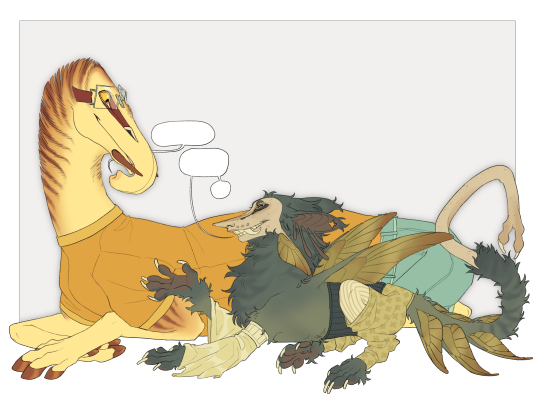
Talita and Firth-nga (Fir) chatting about tusks and antlers, as well as their similarly carnivorous diets
@jayrockin your specbio work has been a HUGE inspiration for me!!! I adore Talita and wanted to draw something out of appreciation for your work. I can't wait to see where RTTS goes next!!!
#specbio#rtts#talita rtts#rtts talita#runaway to the stars#specevo#speculative biology#aliens#I mean. Fir is technically from earth just not THIS earth. so he counts as an alien in my heart#rtts fanart#artists on tumblr#GAHH. SO EXCITED TO POST THIS IM VERY HAPPY WITH IT!!!!#talita is a BEAST to get right when drawing her. had to reference like 4 different artworks of her#also wow shes so YELLOW. I hadn't realised until I colourpicked her for this#shes so extremely awesome#HOPE I GOT HER CLOTHES RIGHT....#if anyone is curious Fir is a kiatsorak!!! they're an amphibious mammalian species from an alternate version of Earth#I came up with them when I was 7 and have not stopped thinking about them since
227 notes
·
View notes
Text

Practicing my reference sheet skills with my freaky goober spec bio sona, ML. This shall help me plan for more difficult references (which would include my OCs). This took me 16 hours and 42 minutes! I am satisfied with my work.
TY AGAIN @myuniverseinabox YIPPEE >:]
#bazookaboi’s art stuff#spec bio#speculative biology#original species#original creature#Sona#reference sheet
99 notes
·
View notes
Text
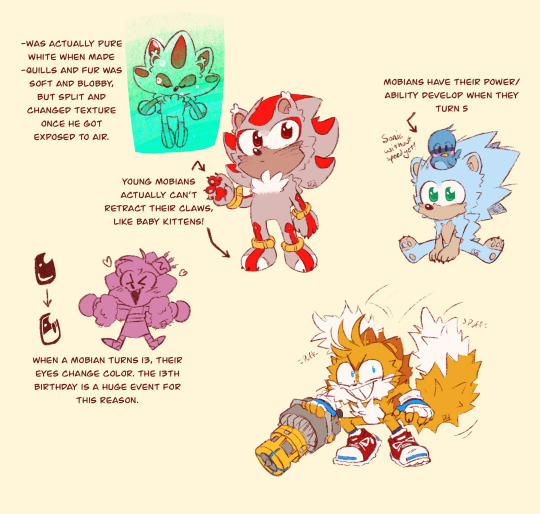
September 12 2023
Some Mobian Biology headcanons, and I doodled Tails when the Sonic Frontiers: Final Horizon Trailer dropped.
Hedgehogs when they are young, have pastel light quills that get darker as they age. Shadow too since he was originally born with pure white blobby quills that gradually turned into the black that we know today.
A Mobians eyes are a good indicator of how young they are. If they are younger than 13, they have dark eyes with only a hint of the true color underneath it. That's why it's a huge celebration when a Mobian turns 13, watching their eyes unveil it's true colors is a huge moment for a Mobian.
A Mobian can be born with or without powers, no one will really know until they are 5 years old, that's when the Chaos Energy inside of them has developed enough to turn into an ability. Most Mobians don't have Chaos Abilities, but it's not completely rare for someone to develop them at 5. The Chaos Ability is normally something that lets you bend Chaos Energy to your will, in the form of things like Pyrokinesis or Aquakinesis. A Chaos ability that lets you boost your physical body is extremely rare and unique, such as super speed or stretching your tail to a comedic length.
#sonic the hedgehog#tails the fox#miles tails prower#shadow the hedgehog#shadow the ultimate lifeform#Mobian Biology headcanons#The Murder of Sonic the Hedgehog reference!
677 notes
·
View notes
Text
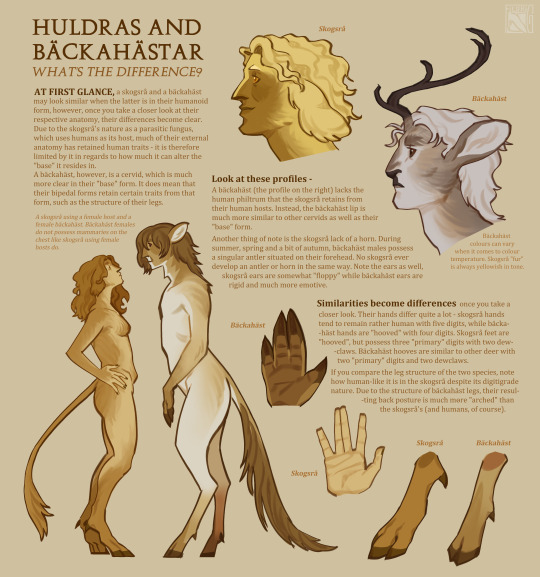
i decided to change a little bit about the bäckahäst humanoid form, and realised that they have some superficial similarities to skogsrå, so heres a thing ironing out their differences a little
#fantasy#huldra#bäckahäst#skogsrå#speculative biology#spec bio#pareidolia tag#bestiary#creature lore#lore#(huldras are referred to as skogsrå as well in pareidolia btw. or irl i guess LOL)#(skogsrå is just the regional term.... the huldra and skogsrå are very similar myths irl so its likely its the case there too)#in case ur ootl bäckahästar in pareidolia can turn into a humanoid... it has to do with the myth of näcken#(basically ppl think they are two different “creatures” but theyre actually the same just in different forms)#worldbuilding
478 notes
·
View notes
Text




a little doodle dump
#been away for awhile! sorry about that#still trying to get home lol#yes that first one is an otgw reference#:3 i just like thinking about it ...#and HS AU ilaw#hes a biology teacher#i love his stupid ass 🫶#anyway#sky children of the light#sky cotl#sky: cotl#sky:cotl#skycotl#sky#sky: children of the light#gay bird (ilaw)#medic bata#starchild (estre)#sky oc#skycotl oc
78 notes
·
View notes
Text
You know, the AAI2 fandom’s insistence on referring to the characters by their fan localized names we’ve had for like a decade instead of the ones we received this week is really funny. It almost reminds me of something…

God damn it.
#ace attorney#aai#aai2#aa investigations#aai collection#ace attorney series#ace attorney shitpost#ace attorney posting#ace attorney investigations#yumihiko ichiyanagi#sebastian debeste#eustace winner#courage the cowardly dog#raymond shields#eddie fender#justine courtney#verity gavelle#real talk: the name Eustace is kind of growing on me. it has the even more pathetic energy than both Yumihiko/Sebastian.#still prefer the fan names though.#that and since I’m a microbiology major I know that ‘eu-‘ as a prefix in biology usually means ‘true’ so it connects to Verity/Justine#and I think that’s kinda cute :)#winner however can go burn.#Eustace will never replace Sebastian I am simply adding it to my list of names to refer to the kid.#<- a list which so far includes: 4kids Akechi. Laywer Iruma-kun. Fluffy Little Bastard. Tall Child. Disconnected Tellytubby. Herr Fluffy.#and now Eustace and Stacey have been added to the mix.#what are some others please add.
213 notes
·
View notes
Text
Facial Scarring (Matt Murdock/Daredevil)
Recently I’ve been thinking about how Matt Murdock in both the comics and the tv show, has little to no obvious physical damage around his eyes, despite being blinded by chemical burns. So I’ve taken it into my own hands to brainstorm some ideas for what the burns might look like.
Keep in mind, I am not a medical professional. The information here is based on publicly available medical information I found in research papers, alongside my limited pre-existing knowledge.
I would also like to state that different types of burns can be caused by different kinds of chemicals, however comprehensive information about this was difficult to find.

The top three images are various types and degrees of corneal scarring. The bottom two are scaring on both the eye and surrounding area.
I love interactions and if you do any art based on this please @ me! Id love to see it! If you have any questions, ask them and I’ll answer in a part two!
#art#my art#forensics#biology#scarred#scarring#marvel#daredevil#matt murdock#science#anatomy#disability#disabled#blindness#reference
70 notes
·
View notes
Text
Writing Notes: Pain

The Importance of Pain
To make you stop doing something that’s damaging you, or that could damage you.
To make you look after an injury, so that it can heal properly.
Just beneath the surface of your skin are damage receptors. They respond to 3 different types of damage or danger:
Extreme heat or cold
Burns from acids or alkalis
Mechanical impacts – such as your knee hitting the ground
[Note: Your brain doesn’t contain any damage receptors. This means a ‘headache’ is never actually a pain in the brain itself.]
When these receptors are triggered, 2 types of signal are sent to your brain:
Fast signals - make you feel pain. This also makes you take action (so you take your hand off a hot pan very quickly, for example).
Slower signals - make the damaged bit start to throb painfully.
All kinds of things can change how much pain you feel.
Just being distracted can make something hurt less, while
being worried about something hurting will almost always make it hurt more.
Sometimes people develop a form of pain that stays. This is called chronic pain. Unfortunately, it’s often very difficult to treat.
Source ⚜ More: Writing Notes & References ⚜ 100 Sensory Words Pain ⚜ Dangerousness ⚜ Wounds ⚜ Injuries ⚜ Getting Bitten ⚜ Bereavement
#writing notes#writeblr#writing reference#dark academia#spilled ink#literature#writers on tumblr#anatomy#biology#writing prompt#poets on tumblr#poetry#writing inspiration#writing ideas#fiction#novel#light academia#creative writing#writing resources
130 notes
·
View notes